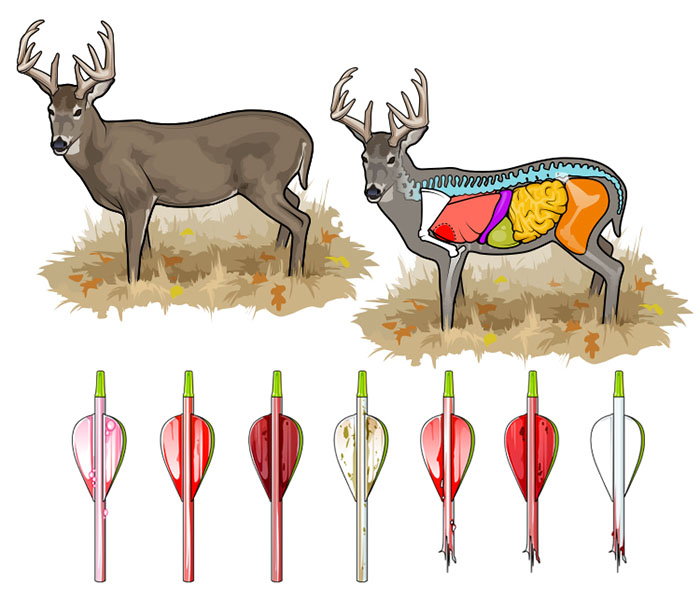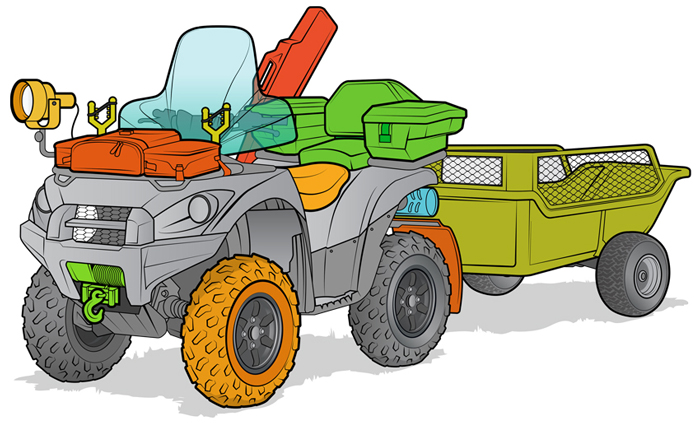
Ryan Kirby’s career as both an illustrator/designer and wildlife artist is a balancing act. He finds stability somewhere in between solving problems for clients like Popular Science, Outdoor Life and Field and Stream, and defining his own challenges through his fine art. Ryan took the time to answer a few questions for us about his work, education and life.
What’s your background? How did you get your start in illustration?
I’ve been drawing and painting since I was in elementary school, and my goal has always been to one day paint full time. But I also knew that once I graduated college, I would need some marketable skills to buy some time before I could paint. So I studied Graphic Design and Multimedia at Bradley University in Peoria, IL and graduated in 2005. I was a farm kid, and we didn’t have access to the software and Mac computers growing up, so college was my first experience with Photoshop, Illustrator, and any real form of print and digital media. I learned to apply my drawing and fine art skills to these programs, and did fairly well in school.
Upon graduation, I headed south of the Mason Dixon to Edgefield, SC to work for the National Wild Turkey Federation as a graphic artist and illustrator. I spent roughly seven years there learning print design, magazine production and editorial illustration. Those were good years, and I learned a lot. Eventually I started freelancing and painting on the side, always pushing myself and trying to learn new programs and techniques. Soon the freelance workload became heavy, and I had to make a decision whether to launch out on my own or stay an employee of someone else. I chose the former.
I’ve been on my own for three years now, and it’s been the best decision I’ve ever made. It’s not always easy, and as a one man show you wear a lot of hats initially, but I thrive on challenge and love learning new things. Most of my clients are in the outdoor industry, and I primarily focus on print ad design, photography post-production work, illustration and wildlife art.
What’s your favorite subject matter or type of illustration?
The how-to hunting pieces are my favorite. I have a passion for the outdoors and really enjoy hunting and fishing. So to illustrate a hunting scenario that I’ve lived out in real life and help a magazine better communicate that concept with a reader, that’s something I enjoy tremendously. It’s one thing to enjoy the technical side and the creative process of illustrating or painting, but to actually care about the subject matter, that’s a whole new level of job fulfillment. And I feel it shows up in my work, which is why I’ve been successful in the outdoor arena.
What’s your process for a typical assignment?
Even with good scrap material and reference photos from a client, I always like to do some more research on my own. Most of my work starts the old fashioned way with pencil and paper. Once I get a rough sketch with potential, I’ll take a cell phone pic, email it to myself and from then on, it’s all digital. If I’m working in Illustrator on a technical piece, I’ll create vector art over the top of the sketch. My humorous work though is done 100% on paper and scanned in to create a digital file for the client. In this day and age, everything has to turn into a digital file at some point to send over to the client.
What’s the relationship between your illustration work and your fine art?
There’s a dramatic difference in the way an illustration is created vs. a fine art piece, and the business side of things is run differently as well. But artistic principles like contrast, edges, focal points, composition, color, etc. apply to both fields. For example, when I want a hard edge on my subject matter in a painting, I paint a clean, hard line with contrasting values. When I want a hard edge on a vector illustration, I simply bump up the stroke width in Illustrator and choose contrasting colors. Same concept, two different ways of accomplishing it. And as with any great fine art piece or technical illustration, the more you can refine a subject down to it’s core essence, the more you simplify it, the more powerful the resulting image.
There are differences though. My illustration and graphic design work is done on a sketchpad and an iMac in my office. It’s clean, precise, orderly. My paintings are done in a separate painting studio. It’s messy, more chaotic, a little more of a mad-scientist atmosphere. In addition, the illustration and graphic design is a service industry, where I solve a client’s problems for a fee. The painting, on the other hand, is a hard good. It’s my own creation, and after I create it I have to find a way to market and sell the piece. It’s more of an entrepreneurial venture than sitting back and handling client requests.
I’ll always do a balanced workload of graphic design, illustration and fine art. But these days I’m shifting that balance to more fine art. There’s no client revising my work or limiting what I can and can’t do. I have more ownership of the creative process, and that’s important to me.

Do you have any advice for illustrators just starting out?
Absolutely. As an illustrator or designer, you are in the business of solving problems. Your clients have problems that they need solutions to, and the level of problem you can solve for them will determine your level of success. For example, I’ve taken it upon myself to learn product photography and new illustration techniques, to understand branding and retail settings, and to craft powerful messages with copy and images. If something is beyond my reach, I seek advice or hire it out. The more problems you can solve effectively for your clients, the more valuable you are to them.
Also, be great to work with. Under-promise and over-deliver. Hit deadlines. Go over the top, not because someone asked you to, but simply because you wanted to see if you could do it. You can be the most talented illustrator in the world, but if you can’t hit a deadline or you’re a jerk to work with, clients will find somebody else. And always remember: emails are forwarded and what you put on Facebook lives forever.
Ryan’s illustration work can be found at RyanKirbyIllustration.com and his wildlife fine art at RyanKirbyArt.com



Wow, very cool work and really inspiring. Thanks for sharing.
I first became aware of Ryan in the pages of Cycle World. Great stuff, very clean style.